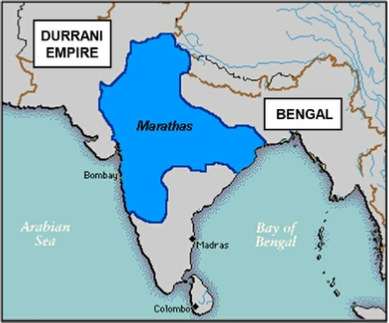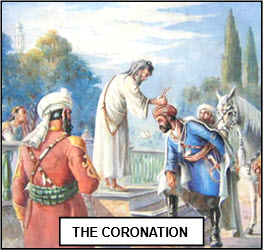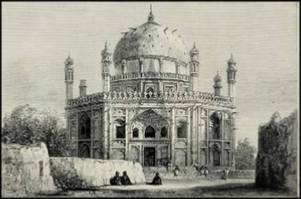


THE BATTLE OF PANIPAT 1761 (G3a)
xxxxxThe Maratha state was founded by Shivaji in 1674. With the death of Aurangzeb in 1707 and the decline of the Mughal Empire, the Maratha slowly gained control of much of central and northern India. Meanwhile, however, as we have seen, following the death of the Iranian leader Nadir Shah in 1747 (G2), his chief bodyguard, Ahmad Shah Durrani, was elected king of Afghanistan and led attacks into northern India. In 1761 he met up with the Maratha army and destroyed it at the Battle of Panipat. This shattered their dream of succeeding the Mughals as rulers of India but, as we shall see, in 1775 they met with some success in the first of the Anglo-
 xxxxxAurangzeb, the last of the great Mughal emperors, expanded his control over most of the Indian sub-
xxxxxAurangzeb, the last of the great Mughal emperors, expanded his control over most of the Indian sub-
 xxxxxAs we have seen, following the death of Nadir Shah in 1747 (G2), the commander of his Afghan bodyguard was crowned king of Afghanistan with the title of Ahmad Shah Durrani (1722-
xxxxxAs we have seen, following the death of Nadir Shah in 1747 (G2), the commander of his Afghan bodyguard was crowned king of Afghanistan with the title of Ahmad Shah Durrani (1722-
xxxxxFor the Marathas, their defeat at Panipat shattered the hopes they had of succeeding the Mughals as rulers of India, (though, as we shall see, in 1775 they were still a force to be reckoned with in the first of the Anglo-

xxxxxAhmad Shah Durrani, founder of the Afghan nation and victor of the Battle of Panipat, was one of history's outstanding leaders. He fought like a soldier and he ruled like a statesman. As an administrator he was well ahead of his time. He governed with the help of a prime minister and a council of nine chiefs, each one responsible for his own particular tribe. He was himself a poet, and his poetry shows a great love for his native Afghanistan. He died in 1772 and was buried in an imposing mausoleum in Kandahar. Next to this building is the mosque of the “Khirqah”, said to contain the cloak of the prophet Muhammed.
xxxxxThe following is part of a poem Ahmad Shah Durrani wrote on the love he had for his country:
By blood we are immersed in love of you
The youth lose their heads for your sake.
I come to you and my heart finds rest
Away from you, grief clings to my heart like a snake,
I forget the throne of Delhi
When I remember the mountain tops of my Pushtun land,
If I must choose between the world and you,
I shall not hesitate to claim your barren deserts as my own.
xxxxxIncidentally, there were three Battles of Panipat. In 1526 the Mongol leader Babur defeated the emperor of Delhi and founded the Mughal Empire in India. Thirty years later, a large Hindu army which had captured Delhi was overthrown by the Mughals, thus confirming Akbar as the Emperor.
Acknowledgements
Map (India): licensed under Creative Commons – en.wikipedia.org. Coronation: detail, by the Afghan artist Ustad Abdul Ghafoor Breshna (1907-
G3a-


